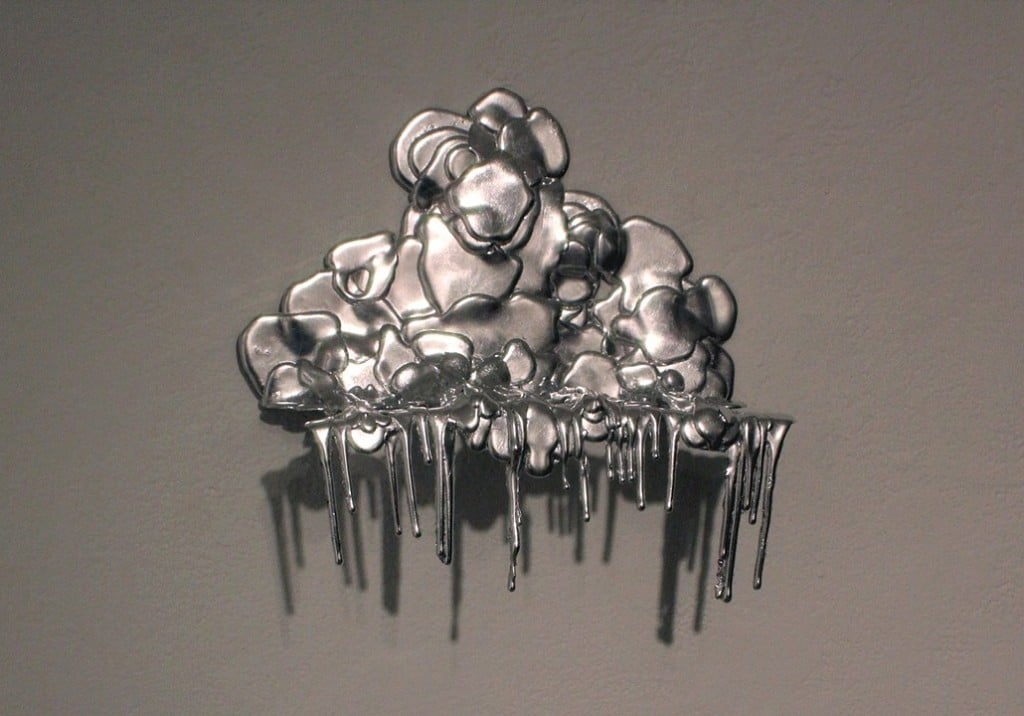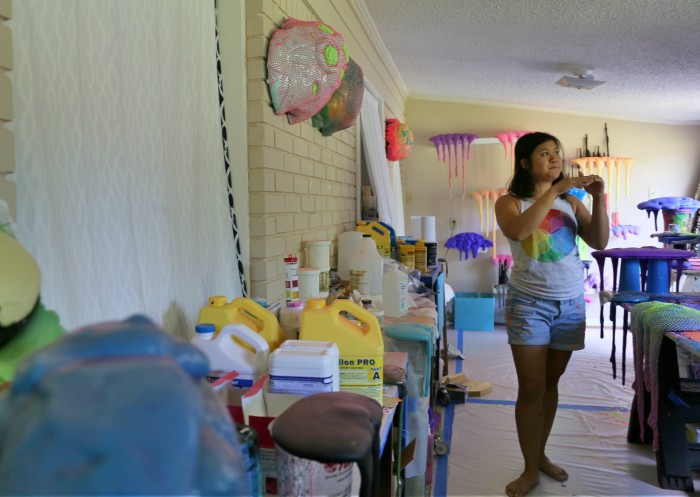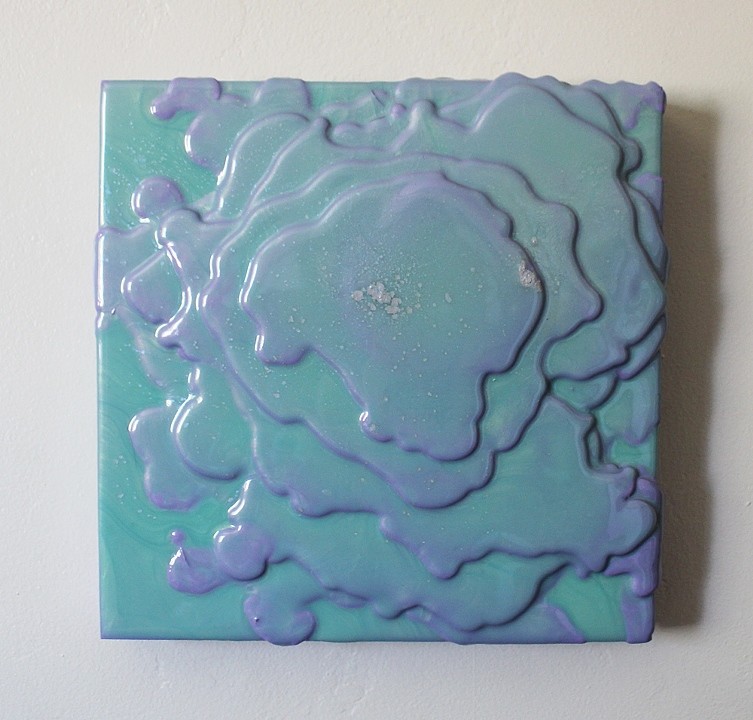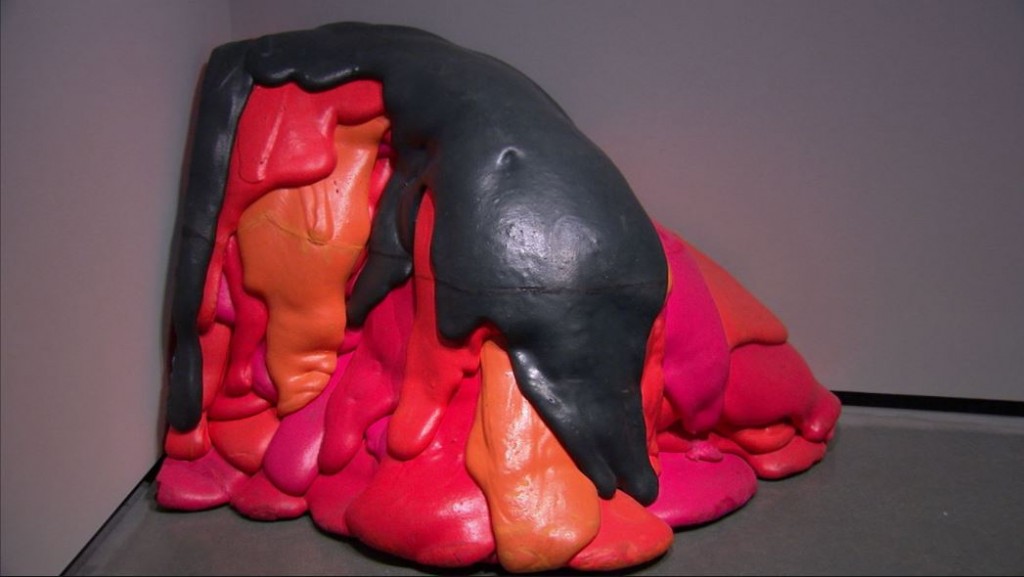Dan Lam Splashes Into Art World With Drip Sculptures
ArtandSeek.net September 14, 2017 19Welcome to the Art&Seek Artist Spotlight. Every Thursday, here and on KERA FM, we’ll explore the personal journey of a different North Texas creative. As it grows, this site, artandseek.org/spotlight, will eventually paint a collective portrait of our artistic community. Check out all the artists we’ve profiled.
At first glance, the free-standing sculptures from Dan Lam’s “Drip” series look like some sort of bizarre biological matter that’s come to life. The bases of the spikey, brightly colored pieces sit on flat surfaces and each of the sculptures sort of ooze over the edge.
If you’re having a hard time picturing them, then imagine a more cheerful version of the killer goo from the 1988 horror flick “The Blob.”
Lam has garnered a ton of attention for these pieces, especially on Instagram. Right now, she’s got 150-thousand followers. And photos and videos of her sculptures receive thousands of ‘likes’ and views.
But Lam wasn’t always a sculptor. She started as a painter. She even has an MFA in Drawing and Painting from Arizona State University.
“So yea, that’s where it started. I was painting and I wanted to build up more and more texture and then that got too heavy,” says Lam. “And then I was like ‘What else? What gives me this look of soft or drippy?’”

“Illuminated” was an early attempt (2010) at making “drippy” art for Dan Lam. It’s made with Hot Glue and Sliverleaf.
Photo: bydanlam.com
Lam wanted to push herself. She wanted to create what she was imagining.
“So there was like, you know, a moment,” Lam recalls. “I went home, went to my studio and I was working on some stuff and I had this kind of thing where I was like, ‘why do we consider painting painting? What happens when I leave the paint surface?’”
Moving away from canvases called for some creativity and patience. There was a lot of trial and error.
“I was using hot glue. [I] used plaster [and] resin,” Lam explains. “And then you know I kept pushing material and continued to look for and find the perfect drippy soft material.”
Eventually she found inspiration in the work of New York artist Lynda Benglis, known for her mastery of materials.
“She had this series of works that she did where she poured polyurethane foam on to a site,” says Lam. “And it just had such a great look. And I was inspired, so I found some and then I just started playing with it and it’s continued to grow from there.”
Lam created her first “Drip” sculpture two years ago. Today she’s still facinated with polyurethane foam and she’s crafted two additional series.
There are “Blobs” – round pieces that sit on the floor or are mounted onto walls – and “Squishes.” “Squishes” are free-standing pieces that sort of resemble headless action figures.
“I get the question a lot like ‘what’s next?’ You know?” Lam says. “And for me I don’t sit down and strive to think ‘How can I make something super different? Or super unique?” But it is just building off of all the things I’ve already been thinking about and continue to grow.”
This process is paying off for the 29 year-old. She’s been invited to show her work at galleries around the world. National publications like Business Insider, VICE News and Juxtapoz have all profiled her. And she was recently named the Artist-in-Residence at Fairmont Hotel in Dallas. Lam appreciates the attention.
But she really enjoys how the work sparks curiosity in audiences.
“I really am interested in how people respond to them. You know they’re always like, ‘I want to touch them. What do they feel like? Is it soft? Is it hard?’ And I really am interested in that dialogue with the audience,” says Lam.
Lam says she’s crafting new works that allow viewers to interact with her sculptures: to touch them, poke them, squeeze them. At this rate, she’ll reinvent Play-Doh.

Lam insider her home studio with materials and equipment taking up one side of the room and art taking up the rest of the space.
Photo: Hady Mawajdeh
Dan we haven’t talked since last year’s solo show”Coquette” at Fort Works Art. For some of the folks who may not have seen your artwork on social media – specifically Instagram – can you tell us a little bit about your art?
So I’ve been making these sculptures for a little less than two years. My first “drip” sculpture was made around January of last year, which isn’t that long, but I make a variety of things. I make shelf pieces, wall sculptures and floor pieces. The work has grown and I’ve been experimenting with more materials.
I’ve started to play with works that are more interactive and I’ve begun shifting my focus within the work. Having my work exposed and having it out there for so many people to see has made me interested in how they respond to the pieces. People are always like, ‘I want to touch them,’ ‘I want to know what they feel like,’ and I’m really interested in that dialogue with the audience. In fact, that’s what has been guiding my newest work (see new interactive pieces below).
These new pieces have been crazy and fun. And the pieces have been continued to grow and it’s allowing me to use new materials.
And we should remind people that sculptures are amorphic, blob-like works that you paint and decorate in a plethora of ways. Some of the works can look like they are dripping off of the wall or they could look like these round circular pieces that look almost molecular. Can you talk a bit about the first few sculptures that you created?
They have a very organic look. I’m inspired by nature and how things are formed in nature. It’s not a super-direct influence, but that’s sort of how I form my pieces. I use polyurethane foam. It’s used a lot in mold making and casting. There are also different forms of it that are used in inflation and more home improvement type projects. It’s a closed cell material. It doesn’t absorb anything. It’s really light. And it kind of reminds me of the body or fat or meat.
Anyway, when I first started using polyurethane foam, I was really interested in manipulating the material. So I started playing with it and watching how it moves and how it works. Learned that there were certain factors that came into play like temperature and humidity. And so yea, they’re very organic in look and approach, but made from synthetic materials.
You’ve been really open about showing the process that you use to create the drips and blobs. You’ve demonstrated the entire process for publications and you’re open about talking what materials that you use. How has that approach helped you become an internet sensation?
I think that for me I’m very interested in materials. I think that it’s fun for me to share my process. And a lot of times because of what I work with and how I work that my process looks a lot different than what other artists are doing.
You know if you’re a painter you can do a time-lapse video of you painting something, which is super interesting and cool. But if I’m working with silicone or a polyurethane foam, that’s something that people aren’t used to seeing. So for me to be able to show that people is really cool. And sometimes my videos can answer questions people have about my work. But sometimes it poses more questions.
For example, I use resin in my work. And sometimes I will post videos of a pour – that’s where Lam pours resin on her sculptures – and people will be so confused about what I am doing. But I want them to see my process.
Not every artist is willing to share the process. That’s pretty brave. Do you think that doing so has inspired other artists to do something like you?
I’ve had quite a few student tag me on Instagram where they’ve said things like ‘I’ve made a Dan Lam inspired “drip.”‘ And the piece will be made out of wood or ceramics. I have had other people tag me and tell me that they’re now trying polyurethane foam. So I think that sharing bits and peoples of my process has helped people expand their mind as to what sorts of materials they can use.
Like I said before, I am really into materials and process so experiment and explore is part of the whole creative process. When you do something that you’re not comfortable with, it’s really fertile ground for more things to come from it. And I guess this could be a really great starting point for a lot of folks who aren’t used to using these materials. I hope it helps them have a bigger tool box.
This isn’t something you just tried to do one day. This is a technique you’ve sort of been in search of for nearly a decade. Can you talk about where this love and desire to create something soft and drippy came from?
There were a few catalyst moments during my schooling. Like when I was in undergrad, I was studying painting and drawing and we were starting to learn about the Impressionism. And we were taught about how Impressionists were not embraced by their peers, because they were seen as not talented. But in reality, the beauty of the Impressionists is that they were freeing paint. They were freeing it from the restrictions of history. Paint had always been used to create illusion, like how real can we make something look. But the impressionists were like ‘no.’ They wanted the looseness of the paint. They wanted to capture the essence of their subjects. And I thought that was really beautiful. Paint could exist in it’s own life.
That inspired me to see what would happen if paint left the surface. It made me want to see where I could take my painting. And it started a nearly decade long pursuit of seeing where I could push texture and material. Then I started to paint things that didn’t exactly fit into any real category. I was using resin, hot glue, all sorts of stuff and painting on that. I was in pursuit of the drippy look, but I can’t tell you why I was drawn to it.
Then during grad school, I looked at Lynda Benglis‘ work and she had this series where she poured polyurethane foam onto a site and it had such a great look and I’ve just kept playing with it since then.
Fort Works Art Gallery Presents Dan Lam from Mika Mitchell on Vimeo.
There have been changes in the texture, color and shape of the sculptures that you create. It’s like every batch or cycle of works has a subtle, yet significant, change. And you’re adapting during a very popular moment in your young career. Are you creatively satisfied with your trajectory?
I’m satisfied with my career. Things are going really really well. But in the studio I think that I am happy with the portions of my process that I’ve been able to streamline. I think that there’s always a level of discomfort that comes from the unknown.
I get asked a lot ‘What’s next?” And I don’t sit down and think how can I make something that’s super different or super unique. I am simply trying to build off of all the things that I’ve been doing and thinking about. It’s about continuing to grow. My work evolves out of itself.
Anyway, I am happy with where I am, but I also think that I should also be a little bit dissatisfied in order for innovation to continue. I think it’s important to challenge yourself and to be out of your comfort zone. And in that way, I am still happy and satisfied because I am still doing that. But I am always trying to push.
Is it hard to keep challenging yourself? Aren’t there days when you don’t want to go into the studio and try to do something that’s difficult or new?
That happens. But there are a lot of things that happen in the studio that people don’t see. While I do have this large social media following and I get to share so much with my followers, there are just a ton of things that just happen that don’t make it to Instagram. But yea for me if anything gets boring then it’s time to move on. If I’m not interested in my own work or the process of making it – if I’m ever like, ‘ugh! I don’t want to work.’ – that doesn’t happen. If that does happen then there’s something that’s off and that isn’t calibrated right. It’s either that I need some time off or there’s something within the process that’s not right.
Otherwise I go full force. I take a lot of risks. I think that can be hard for a lot of people. But I really like the challenge. I like the weird stuff that comes out of that.
Interview questions and answers have been edited for brevity and clarity.







 : @ben.willis.art
: @ben.willis.art







